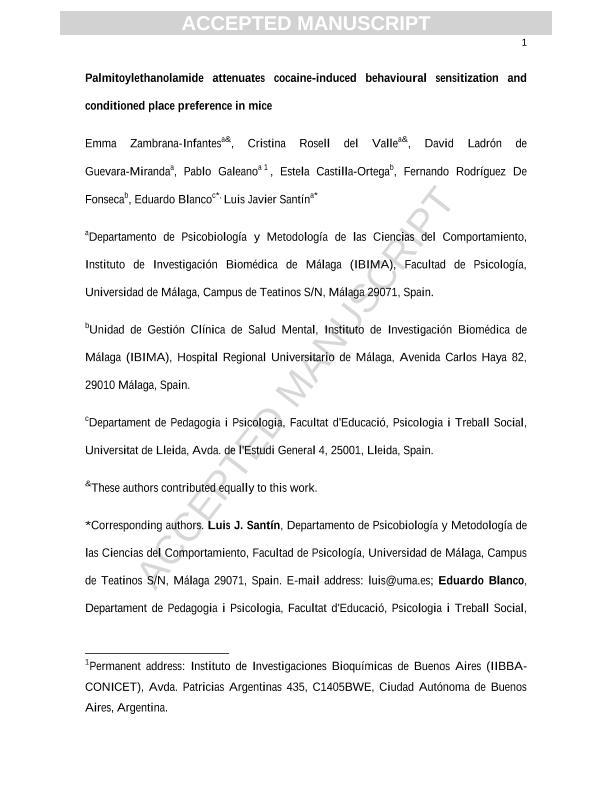Artículo
Palmitoylethanolamide attenuates cocaine-induced behavioral sensitization and conditioned place preference in mice
Zambrana Infantes, Emma; Rosell del Valle, Cristina; Ladrón de Guevara Miranda, David; Galeano, Pablo ; Castilla Ortega, Estela; Rodríguez De Fonseca, Fernando; Blanco, Eduardo; Santín, Luis Javier
; Castilla Ortega, Estela; Rodríguez De Fonseca, Fernando; Blanco, Eduardo; Santín, Luis Javier
 ; Castilla Ortega, Estela; Rodríguez De Fonseca, Fernando; Blanco, Eduardo; Santín, Luis Javier
; Castilla Ortega, Estela; Rodríguez De Fonseca, Fernando; Blanco, Eduardo; Santín, Luis Javier
Fecha de publicación:
03/2018
Editorial:
Pergamon-Elsevier Science Ltd
Revista:
Pharmacology Biochemistry and Behavior
ISSN:
0091-3057
e-ISSN:
1873-5177
Idioma:
Inglés
Tipo de recurso:
Artículo publicado
Clasificación temática:
Resumen
Cocaine addiction is a chronically relapsing disorder characterized by compulsive drug-seeking and drug-taking behaviors. Previous studies have demonstrated that cocaine, as well as other drugs of abuse, alters the levels of lipid-based signaling molecules, such as N-acylethanolamines (NAEs). Moreover, brain levels of NAEs have shown sensitivity to cocaine self-administration and extinction training in rodents. Given this background, the aim of this study was to investigate the effects of repeated or acute administration of palmitoylethanolamide (PEA), an endogenous NAE, on psychomotor sensitization and cocaine-induced contextual conditioning. To this end, the potential ability of repeated PEA administration (1 or 10 mg/kg, i.p.) to modulate the acquisition of cocaine-induced behavioral sensitization (BS) and conditioned place preference (CPP) was assessed in male C57BL/6J mice. In addition, the expression of cocaine-induced BS and CPP following acute PEA administration were also studied. Results showed that repeated administration of both doses of PEA were able to block the acquisition of cocaine-induced BS. Furthermore, acute administration of both doses of PEA was able to abolish the expression of BS, while the highest dose also abolished the expression of cocaine-induced CPP. Taken together, these results indicate that exogenous administration of PEA attenuated psychomotor sensitization, while the effect of PEA in cocaine-induced CPP depended on whether PEA was administered repeatedly or acutely. These findings could be relevant to understand the role that NAEs play in processes underlying the development and maintenance of cocaine addiction.
Archivos asociados
Licencia
Identificadores
Colecciones
Articulos(IIBBA)
Articulos de INST.DE INVEST.BIOQUIMICAS DE BS.AS(I)
Articulos de INST.DE INVEST.BIOQUIMICAS DE BS.AS(I)
Citación
Zambrana Infantes, Emma; Rosell del Valle, Cristina; Ladrón de Guevara Miranda, David; Galeano, Pablo; Castilla Ortega, Estela; et al.; Palmitoylethanolamide attenuates cocaine-induced behavioral sensitization and conditioned place preference in mice; Pergamon-Elsevier Science Ltd; Pharmacology Biochemistry and Behavior; 166; 3-2018; 1-58
Compartir
Altmétricas



